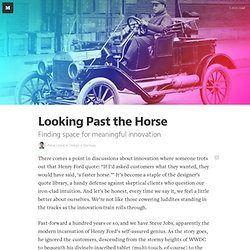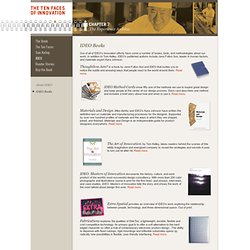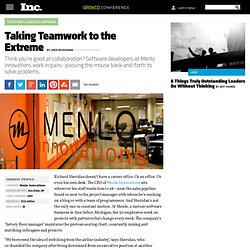

Design Thinking Action Lab. Solve 50 problems in 50 days. Looking Past the Horse — Editor's Picks. There comes a point in discussions about innovation where someone trots out that Henry Ford quote: “If I’d asked customers what they wanted, they would have said, ‘a faster horse.’”

It’s become a staple of the designer’s quote library, a handy defense against skeptical clients who question our iron-clad intuition. And let’s be honest, every time we say it, we feel a little better about ourselves. We’re not like those cowering luddites standing in the tracks as the innovation train rolls through. Fast-forward a hundred years or so, and we have Steve Jobs, apparently the modern incarnation of Henry Ford’s self-assured genius. As the story goes, he ignored the customers, descending from the stormy heights of WWDC to bequeath his divinely-inscribed tablet (multi-touch, of course) to the teeming masses. Horses & Cars Let’s start with Henry Ford. It’s not that he didn’t pay attention to the customers, but that he paid more attention to the customers than they paid to themselves.
The Ten Faces of Innovation » The Ten Faces. The Learning Personas Individuals and organizations need to constantly gather new sources of information in order to expand their knowledge and grow, so the first three personas are learning roles.

These personas are driven by the idea that no matter how successful a company currently is, no one can afford to be complacent. The world is changing at an accelerated pace, and today's great idea may be tomorrow's anachronism. The learning roles help keep your team from becoming too internally focused, and remind the organization not to be so smug about what you “know”. People who adopt the learning roles are humble enough to question their own worldview, and in doing so they remain open to new insights every day. The Anthropologist is rarely stationary. The Ten Faces of Innovation » IDEO Books. Out of all of IDEO's innovation efforts have come a number of books, tools, and methodologies about our work.

In addition to Tom Kelley, IDEO's published authors include Jane Fulton Suri, leader in human factors, and materials expert Kara Johnson. Thoughtless Acts? Is a book by Jane Fulton Suri and IDEO that invites you to notice the subtle and amusing ways that people react to the world around them. Read more. IDEO Method Cards show fifty-one of the methods we use to inspire great design and keep people at the center of our design process. Materials and Design. The Art of Innovation, by Tom Kelley, takes readers behind the scenes of this wildly imaginative and energized company to reveal the strategies and secrets it uses to turn out hit after hit.
IDEO: Masters of Innovation documents the history, culture, and work product of the world's most successful design consultancy. A Design and Innovation Consulting Firm. People. Tom Kelley, IDEO - Young at Heart: How to Be an Innovator for Life. How to design breakthrough inventions - 60 Minutes.
SPACE - Taking Teamwork to the Extreme. Most Audacious Companies: Menlo Innovations. Richard Sheridan doesn’t have a corner office.

Or an office. Or even his own desk. The CEO of Menlo Innovations sits wherever his staff wants him to sit--near the sales pipeline board or next to the project manager with whom he’s working on a blog or with a team of programmers. And Sheridan’s not the only one in constant motion. At Menlo, a custom-software business in Ann Arbor, Michigan, the 50 employees work on projects with partners that change every week. "We borrowed the idea of switching from the airline industry," says Sheridan, who co-founded the company after being downsized from an executive position at another technology firm.
The practice also builds in perpetual learning as employees effectively mentor each other all the time. The variety of partners and tasks also keeps employees from burning out on projects that sometimes roll out over years. The 25 Most Audacious Companies. Make Space. Make Space (John Wiley & Sons, 2012) is a new book based on the work at the Stanford University d.school and its Environments Collaborative Initiative.

It is a tool for helping people intentionally manipulate space to ignite creativity. Appropriate for designers charged with creating new spaces or anyone interested in revamping an existing space, this guide offers novel and non-obvious strategies for changing surroundings specifically to enhance the ways in which teams and individuals communicate, work, play—and innovate. This work is based on years of classes and programs at the d.school including countless prototypes and iterations with d.school students and spaces. CLICK BELOW TO DOWNLOAD THREE HOW TO SPREADS FROM THE BOOKZ-RackT-WallFoam CubesHiding Place Make Space breaks down content into 5 buckets: Tools—tips on how to build everything from furniture, to wall-treatments, and rigging Situations—scenarios, and layouts for sparking creative activities.
Venture Lab - Sign In. Sign In Sign Inwith your Comcast account Sign in with your NovoEd password Forgot Password?
